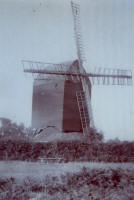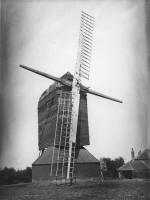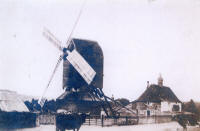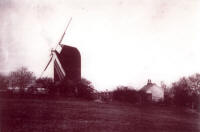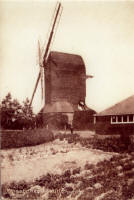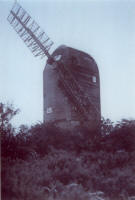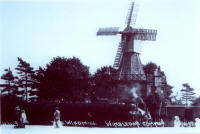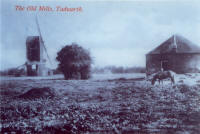(1) Photographic Records
(2) Photograph of Roundhouse Only
(3) Mills Depicted on Paintings
(4) Mills on Line Drawings Only or No Picture back to top of page
(5) Mills in the London area - Line Drawings or No Pictures back to top of page
There were at least eleven other post mills that stood within the old boundaries of the County of Surrey but their sites are now included in Greater London. All of these disappeared from the scene many years ago and the information about them is sparse.
Banstead, Hundred Acres Mill (approx. 13.2 miles NNE of Lowfield Heath)
Hundred Acres Mill was one that was unique in Surrey in that the buck had substantial panniers attached each side of it. It stood “on the left-hand side of the entrance gates (to Banstead Hospital) between the present villa and the chaplain’s house and is shown on a site plan of the hospital dated 1873”. The millers included William Ashby (?-1819) and a Mr Jenden (1819-1835?). It was demolished in 1877 at about the time of the building of the mental hospital. The date of construction of the mill is not known but was probably about 1800. No information is available about the mill machinery although the sweeps appear to have been of the common type. The side panniers extended up two floors and each had a separately gabled roof giving the mill a strange appearance.
Coulsdon Common (approx. 11.5 miles NNE of Lowfield Heath)
This mill was one of a pair which stood on Coulsdon Common. It was probably built about 1770 and was working until 1893 at which time it was owned by the Bryon family who were the Lords of the Manor of Coulsdon. Mr Edmund Byron of Coulsdon Court looked after the upkeep of the mill until about 1912. From then on, its fabric deteriorated and by 1917 it was derelict and threatened with destruction. The mill was sold as part of the Coulsdon Court estate to Mr. W. Wood in 1922 and had completely gone by 1925. The Dewdney family, well known in Surrey milling circles, ran the mill from as early as 1780 to 1826. It was powered by one pair of common and one pair of patent sweeps and had two pairs of stones.
|
|||||
|
|
|||||
Holmwood Common(approx. 4.7 miles NW of Lowfield Heath) back to top of page
This was the furthest west of Surrey’s post mills and was probably a replacement for an older mill on the site. Built about 1775, the copyhold was held by the Manor of Dorking and its millers included John Hutchins (1839-?) and Joseph Killick (1852-?). The windmill and mill house together with a dairy, a shop and several outbuildings were offered for sale in 1855 by the Manor of Dorking. Mr Killick was given as tenant/miller at that time and he was still at the mill in 1862. The sale notice said the roundhouse had an internal diameter of 25ft and that the 32ft patent sweeps drove a pair of 3ft 10in burrs and a pair of 4ft 2in peaks. The stones were probably over-driven. A photograph of the dilapidated mill shows that towards the end of its life it had one pair of common sweeps as well as one pair of patents.
|
|||||
|
|
|||||
Limpsfield Chart (approx. 14 miles ENE of Lowfield Heath) back to top of page
This mill, built in about 1817, is unique among Surrey’s mills in that it was the only one to have clockwise sweeps. It stopped work in 1897 and it was demolished in 1925. Not only were its sweeps unusual for Surrey but it also had a close fitting circular skirt attached to the underside of its buck extending down to the roundhouse roof and replacing the normal petticoat. This must have resulted in added protection against the weather. The last miller was Bill Nash who ran the Chart Mill from 1876 to 1897. It was powered by one pair of common and one pair of patent sweeps and it had two pairs of under-driven(?) stones.
|
|||||
|
|
|||||
Mitcham Common (approx. 13.3 miles N of Lowfield Heath)
The mill on Mitcham Common was built in 1806 after John Blake Barker of Mitcham was granted half an acre of land on the common. He had previously obtained the written consent of the tenants of the Manor of Biggin and Tamworth to allow him to build the mill. Its working life was limited to about 50 years as in 1878 it was struck by a “ball of fire” which destroyed a pair of sweeps. As at this date, the mill had not worked for almost 20 years, no repairs were carried out and the mill deteriorated until it was demolished in 1906 leaving only the roundhouse which is still standing today. It has been suggested that Mitcham Common was a hollow post mill with the stones in the roundhouse and this is partly confirmed by the literature and by a visual examination carried out in June 1955. (See Wimbledon Common below for more details about hollow post mills). It is probable that the sweeps were of the common type and were, unusually for Surrey, mounted on an iron cross.
Mugswell (approx. 9 miles NNE of Lowfield Heath) back to top of page
Most probably built in 1821, it is suggested this mill was a replacement for the one mentioned in a 1772 deed and shown on the 1790 map. It was worked by a succession of millers including William Franks, 1831-c1855, and Walter H. Cooke, 1879-1895. In its later working days, it was used to supplement the capacity of Wray Common tower mill in Reigate. Its working life ceased in 1895 and it was sold to a Dr. Freshfield shortly after. He was responsible for demolishing the buck in about 1912, the roundhouse then becoming a garden store. This is still standing today. The mill was powered from about 1837 by pairs of common and of spring shutter sweeps, then by two pairs common and finally by one pair common and one pair spring. It had two pairs of over-driven stones (one peak, one burr).
Nutfield (approx. 8.2 miles NE of Lowfield Heath)
This mill stood on the parish boundary between Nutfield and Blechingley. It was variously known as Bottery’s Mill or Woolpits Mill. It was probably built in the late 1600’s as a mill was recorded on this site in 1680. It ceased work in 1914 and was demolished in December 1929. Thomas Beale was miller here in the 1830’s and Edward Scott operated it from 1874 to 1885 before he moved to Outwood smock mill. Nutfield Mill was powered by one pair of common and one pair of patent sweeps and had two pairs of stones.
Outwood (approx 6.5 miles NE of Lowfield Heath) back to top of page
The post mill at Outwood was built in 1665 and is one of the oldest in England that is still working. For about 160 years, it was one of a pair of mills on this site, the other being its one time rival, a smock mill, that collapsed in 1962. The pair were known locally as The Cat and The Kitten and , in the early 1800’s , they were operated independently by two brothers who had fallen out after a family dispute. Two well known Surrey milling families, the Jupps and the Budgens owned and ran these two mills for many, many years. Outwood post mill has the distinction of being one of the first mills that the Windmill Section of the Society for the Protection of Ancient Buildings helped to repair (1931-32). In about 1900, it was powered by one pair of common and one pair of double shuttered spring sweeps, then from about 1905 until about 1954, by two pairs of double shutter elliptical spring sweeps and finally from 1954 onwards by two pairs of single shutter elliptical spring sweeps. The mill has two pairs of over-driven stones, one peak and one burr.
|
|||||
|
|
|||||
Shellwood near Leigh (approx. 3.6 miles NNW of Lowfield Heath)
Shellwood Mill is shown on most Surrey maps from 1729 onwards although it was destroyed by fire during this time and was rebuilt. It stood where Shellwood Road and Green Lane intersect. From before 1795 till 1806, the mill was held by James Bowyer, a member of a well known family of Surrey millers. It was then sold to the Edes, also a prominent Surrey milling family, who held it to the early 1900’s. It was working up to about 1907 and was demolished sometime between 1915 and 1925. The roundhouse was used as a pigsty till 1936 when it too was demolished. It was a large mill and was powered by two pairs of double shuttered patent sweeps. It had two pairs of under-driven stones (one peak, one burr).
Reigate, Blackborough Mill (approx. 6.3 miles NNE of Lowfield Heath)
One of the six windmills that stood within one and a half miles of Reigate Town Hall, Blackborough Mill was built about 1736 by John Heaver, miller at Sidlow Watermill. The Heaver family were at the mill until 1826 and the Lamberts took it over in about 1840 and continued to operate it until 1894. Edward Lambert, Junior, was elected Mayor of Reigate in 1877 and 1878. It is recorded in the Parish Register that Elizabeth Webb died in 1799 after being struck by its sweeps. It is also said that a donkey was killed by them in 1894 on the last occasion the sweeps were turned. The mill gradually deteriorated in the early 1900's and it was demolished in 1936. Blackborough Mill was powered by two pairs of common sweeps and had two pairs of over-driven stones (peak and burr). It had a cartwheel on the end of the tail pole, a feature only seen in Surrey on Camberwell Mill otherwise. One of the peak stones from Blackborough Mill is now leaning against the roundhouse wall at Lowfield Heath Mill.
|
|||||
|
|
|||||
Reigate Heath (approx. 5.9 miles N of Lowfield Heath) back to top of page
Another of Reigate’s six mills, Reigate Heath Mill is thought to have been built about 1760. For most of the early 1800’s, it was run by the Bowyer family who also operated at Wonham Watermill. It was sold to Henry Lainson in April 1868 and shortly after this, it ceased work. In 1880, Henry Lainson of Colley Manor requested that the roundhouse of the mill should be converted to a Chapel connected to Reigate Parish Church. The Mill Chapel or more correctly St Cross Chapel, was consecrated for divine worship on 14th September 1880 and it is used regularly as a Chapel today. The mill was bought by Reigate Heath Golf Club in 1900 and sold by them to Reigate Borough Council in 1962 who are still its owners. It has been restored/repaired several times since 1900 by both Reigate Heath G.C. and Reigate B.C.. Reigate Heath Mill was powered by two pairs of double shuttered patent sweeps and has two pairs of under-driven stones (one peak, one burr) in the breast.
|
|||||
|
|
|||||
Tadworth (approx. 9.2 miles N of Lowfield Heath) back to top of page
Another of Surrey’s mill sites with two mills, both post, Tadworth still has the sweep-less body of one of these with some equipment inside. It was probably built about 1760 and is thought to be unique among Surrey mills as it had a two storey roundhouse. The mill lost one pair of sweeps in 1893 and continued working with one pair until 1902. The second pair fell off in 1921. The body of the mill has been well maintained over the years. The Smith family had a long association with Tadworth mills as miller John Smith was there from c1795-1831 and again in 1834, Mrs E. Smith in 1845, J. H. Smith in 1874-78 and E. W. Smith 1887-1903. It was powered by two pairs of elliptical spring sweeps and had two pairs of under-driven stones (one peak, one burr).
|
|||||
|
|
|||||
Wimbledon Common (approx. 18.6 miles N of Lowfield Heath)
Although now classed as a London mill, Wimbledon Common Mill stood inside the old Surrey boundaries and is thus included in this survey of Surrey post mills. Its construction was first proposed in 1799, but it was not until 1816/17 that permission was granted for a piece of common land to be used for the purpose. It was built as a hollow post mill and still stands, in a preserved condition, today. It has a very distinctive appearance with the post mill standing on top of a two storey octagonal brick building. It is not recorded when it stopped working but it was some time before 1880. By 1893, its structure had deteriorated and discussions about its repair or demolition took place. It was decided to repair/rebuild the body and this was completed in November 1893. The mill is now smaller than the original but it looks the same superficially. It has recently been fully restored and is open as a museum of milling. The original mill was powered by two double shuttered patent sweeps and it was turned into the wind by a fantail. The number of stones it drove is not recorded but it was probably two pairs.
In a hollow post mill such as this and Mitcham Common Mill, the sweeps drove a brake wheel which meshed with a wallower at the top of an upright shaft. This shaft passed right down the hollowed centre of the main post into the base of the mill where it was supported on a bearing. Near the bottom of this shaft was a great spur wheel which, in turn, under-drove the stones via the stone nuts.
|
|||||
|
|
|||||
Tadworth Old Mill (approx. 9.2 miles N of Lowfield Heath) back to top of page
It was noted above that the Tadworth site had two post mills on it for many years. The Old Mill was probably built just before the second mill (i.e. 1750’s). It had a single storey roundhouse which can be seen on one old photograph of the area. It was demolished in 1890, its post being sawn through and the body pulled over by five horses. The roundhouse was demolished in 1911 to make way for the house called “Millfield”. No details of its machinery are recorded other than it had a cast iron windshaft.
|
|||||
|
|
|||||
Hookwood (approx. 2.6 miles NE of Lowfield Heath) back to top of page
Hookwood Mill was probably built about 1820 on a circular enclosure on High Hookwood Common. It ceased work about 1880-1890 and was demolished in 1896. It was a tarred mill and it had a one storey roundhouse. It was powered by two pairs of double shuttered patent sweeps, painted white. The buck was winded by a tail pole mounted fantail and it was the only Surrey known to have this feature. It had one pair of peak and one pair of burr stones, both under-driven. The mill was run for many years by the Eastland family. One high quality watercolour showing the mill and its fantail is known to exist.
Horley (approx. 4.1 miles ENE of Lowfield Heath)
Horley Mill was probably built c1700-1750 and its site is recorded on many Surrey maps. It stood near the Smallfield Road about where this road joined Langshott Lane. It was worked until about 1875 and was powered by four common sweeps. It had one pair of peak and one pair of burr stones that were over-driven. After it ceased work, it rapidly deteriorated and it was demolished in about 1900. In 1966, one badly weathered burr stone was found in Mill Croft, a few yards from its site. The only pictures of Horley mill are small, poor quality paintings.
Merstham (approx. 8.9 miles NNE of Lowfield Heath) back to top of page
This mill stood on the north side of Rockshaw Road and was demolished on 7.10.1896 to allow the Brighton Railway Company to construct a cutting and a bridge for their second railway line. In 1784, Thomas Durrant was miller at Merstham Watermill and he built the windmill in about 1786 at his own expense in order to extend his business. He ran both mills for some years but in 1809, quarrying near the watermill caused the millstream to dry up, forcing him to stop working the watermill. He successfully sued a Merstham business man for loss of business. The water supply was not restored until 1820. No doubt Thomas was pleased he had had the foresight to build the windmill. In 1822, the windmill tenancy had past to James Dives, who was also tenant miller at King‘s Mill South Nutfield and at Coulsdon Mills. In 1840, Michael Stacey took over and he and his son, William, operated Merstham Windmill until it stopped work in 1896. The Stacey’s also ran the watermill until 1903. After the demolition of the windmill, its windshaft, two millstones and probably some timbers were used to construct the lych gate at Merstham Church which carries the inscription “Erected in Memory of William Stacey by his widow and family.” Some millstones were also reported to be in the gardens of two Merstham houses. Little is known about the machinery of the mill other than it was driven by one pair of common and one pair of spring sweeps mounted on a cast iron windshaft and that it had one pair of 4ft 6in peak and one pair of 4ft 6in burr stones. Several paintings and engravings of Merstham Mill are known to exist.
Caterham Common (approx. 11.2 miles NNE of Lowfield Heath) back to top of page
Built about 1696, Caterham Common Mill stood between Chaldon and Caterham just north of St Lawrence’s Hospital. Richard Dewdeny, who had interests in several other Surrey mills, took over this mill in about 1790. Many other tenants/millers are recorded before and after this date. It is not known when it stopped working but it was probably c1850 and shortly after this it was demolished. The deeds of St Lawrence’s Hospital, dated 1870, make no mention of this mill. It has been suggested the mill was of the open trestle type but no details of its sweeps or machinery are recorded.
Coulsdon Common, Old Mill (approx. 11.5 miles NNE of Lowfield Heath)
The second mill at Coulsdon Common was built about 1750 and stopped work in about 1850 at which time it was only grinding grist. It was demolished in about 1880. It was powered by two pairs of common sweeps and had one pair of peak and one pair of burr stones.
Epsom Wells (approx. 12.4 miles NNW of Lowfield Heath)
There is no reference to this mill before 1794 but it was mentioned in the 1795-96 Land Tax records. It was offered for sale by auction in 1809 and again in 1818 and the mill details said it was fourteen feet wide with one pair of peak and one of burr stones in the breast (suggesting it was under-driven). The windshaft had a cast iron neck and head and the common sweeps carried “Eleven Yards of Canvas”. It was described in 1900 by the Sussex millwright, Peter Payne, as one of the largest post mills in England with a tip to tip sweep span of 72ft. It was worked up to the day it caught fire and burnt down probably on “Oaks” day in 1880.
Godstone (approx. 10 miles NE of Lowfield Heath) back to top of page
Godstone Mill was probably built about 1800-1810 and was run by Richard Dewdney until just before 1840 by which time the miller was Henry Rose. In 1876, it was operated by Russell Hall who also worked Ivy Watermill nearby. In the late 1870’s, a young girl was killed when she was struck by a sweep of the working mill. At about the same time, the mill stopped working. By the late 1880’s, the mill was a total wreck and soon after was demolished or fell over. There were still some remains to be seen in 1930. It was probably powered by one pair of common and one pair of shuttered sweeps. The windshaft was of wood with a cast iron poll end (see drawing in R. Thurston Hopkins “Old Watermills and Windmills”).
Reigate, Cockshot Hill Mills (approx. 5.6 miles NNE of Lowfield Heath)
Although it is an established and undisputable fact that there were two windmills on Cockshot Hill just south of Reigate, there is probably no photograph or painting of them. In 1747, Mary Dewdney, another member of this Surrey milling family, was allowed to pull down an old windmill on the site and replace it. It is then recorded that in 1748 and 1749 two post mills were built on Cockshot Hill. The Dewdney family continued to be associated with the mills until about 1830. It appears the first mill was demolished about 1845 and that the second stopped work in the 1870’s and was demolished in 1892-93. Mrs Elphick, another of Surrey’s lady millers whose husband ran Flanchford Watermill, Reigate, is recorded as miller between 1866-1870. No details are known about the machinery of either mill.
Warlingham, Chelsham Mill (approx. 13.8 miles NE of Lowfield Heath)
Chelsham Mill dates from the mid 1700’s and is marked on Rocque’s Map of Surrey 1762. In 1803, Phillip Lacres, aged 32, miller was killed by a mill sweep at Chelsham. In 1827 it was sold to John Phillipson, the sale details noting it had two pairs of stones, 24ft cross trees and “patent spring sails”. In April 1837, a new pair of patent sweeps and associated striking gear was fitted by the millwright Ashby of Westerham at the cost of £125. The mill was burnt down shortly afterwards (1840’s). back to top of page
Barnes Common (approx. 22 miles N of Lowfield Heath) had a post mill from earlier than 1740 to at least 1780 when it was destroyed by a hurricane. It was replaced in about 1783 by a smock mill. Contemporary drawings of the post mill suggest it was an open trestle mill with common sweeps.
Nine Elms, Battersea (approx. 23 miles NNE of Lowfield Heath) existed from as early as 1753 and it was there as late as 1814. It is described as a typical Surrey post mill with a roundhouse and four common sweeps. There is no reference to the mill after 1823.
Bermondsey (approx. 25 miles NNE of Lowfield Heath) had post mills at Poupart’s Farm and at Bermondsey Priory. Poupart’s Mill was shown on Bowen’s 1753 map and was burnt down in 1866. It was a standard Surrey post mill, white painted with a roundhouse. Abbey Mill also had a roundhouse, though regrettably its date of construction and demolition are not recorded. In its later life, it was used for grinding colours. back to top of page
Camberwell also had two post mills, one called Freeman’s Mill (approx. 24 miles NNE of Lowfield Heath) the other, Bree Kill Mill at Dulwich (approx. 21 miles NNE of Lowfield Heath). Etchings of Freeman’s Mill show it to have had a wooden roundhouse, common sweeps and there was a cartwheel on the end of the tail pole (a feature also seen on Blackborough Mill Reigate). It stood from before 1753 to after 1831. Bree Kill Mill on Dulwich Common had a strong appeal for artists and one of the best drawings of it is by David Cox in his “Treatise of Landscape Drawing and Effect”, 1814. This shows it with a roundhouse, porch, common sweeps, wooden windshaft and a roof bulge to accommodate the brake wheel.
|
|||||
|
|
|||||
Clapham post mill (approx. 22 miles NNE of Lowfield Heath) dates from earlier than 1631 and it may have gone by the mid 1700’s. It has one of the earliest inventories of milling equipment for a Surrey post mill on record (full details given in Michael Short’s “Windmills in Lambeth”, 1971). In this, there is no mention of a roundhouse, there was one pair of 5ft diameter millstones and the sweeps were classified as covered with cloth. back to top of page
Richmond post mill (approx. 20 miles NNW of Lowfield Heath) was shown on Moses Glover’s map of 1635 and it was still in existence in 1714. It had gone by 1764. No details of its construction are known.
Southwark and Newington (approx. 24 miles NNE of Lowfield Heath) had two post mills, one at St George’s Field, the other at Maid Lane (Park Street). The first stood from before 1632 and was probably demolished in 1773. Maid Lane Mill was of the hollow post mill type and dated from before 1746. It was demolished in about 1820. It had four common sweeps and from an existing line drawing, bore a strong similarity to Wimbledon Common Mill. It is variously said to have ground bones, corn, paint, gypsum and manure.
Wandsworth post mill (approx. 22 miles NNE of Lowfield Heath) stood on the banks of the Thames between the River Wandle and a brewery a short distance east. It was moved to this site from Putney Heath. Its dates of construction and demolition are difficult to ascertain but it probably stood in the 1600-1700’s. A watercolour of it shows a roundhouse, porch and common sweeps. back to top of page or return to Home page
